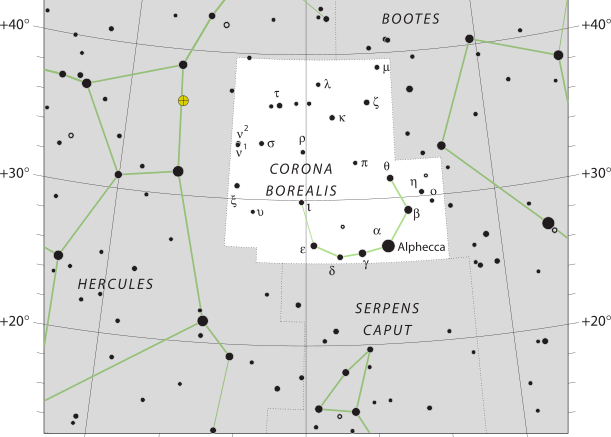Located in the northern celestial gemisphere, Corona Borealis is a small constellation that was 1 of 48 constellations listed by 2nd century astronomer Ptolemy. Its Latin name, inspired by its shape, means “northern crown”.
In classical mythology Corona Borealis represents the crown given by the god Dionysus to the Cretan princess Ariadne and set by him in the heavens. This pattern has been interpreted by other cultures to a variety of thins including a circle of elders, an eagle’s nest, a bear’s den, or even a smokehole. Ptolemy also listed a southern counterpart, Corona Australis, with a similar pattern.
The brightest star is the magnitude 2.2 Alpha Coronae Borealis and the brightest stars in the constellation form a semicircular arc. Covering 179 square degrees and hence 0.433% of the sky, Corona Borealis ranks 73rd of the 88 modern constellations by area. The whole constellation is visible to observers north of 50°S, and its counterpart, Corona Australis, being visible in the Southern Celestial Hemisphere
| Applicable Information | |
| Visibility In Pacific Northwest | January to November |
| Best Times To View | July |
| Right Ascension | 15h 16m 03.8205s–16h 25m 07.1526s |
| Declination | 39.7117195°–25.5380573° |
| Area | 179 square degrees |
| Main Stars | 8 |
| Brightest Object | α CrB, otherwise known as Alphecca or Gemma |
| Meteor showers | 0 |
| Messier objects | 0 |
| Neighboring Constellations | Hercules, Boötes, Serpens Caput |
Mythology
Greek mythology links Corona Borealis to the legend of Theseus and the minotaur. It was generally considered to represent a crown given by Dionysus to Ariadne, the daughter of Minos of Crete, after she had been abandoned by the Athenian prince Theseus. When she wore the crown at her marriage to Dionysus, he placed it in the heavens to commemorate their wedding.
The Latin author Hyginus linked it to a crown or wreath worn by Bacchus (Dionysus) to disguise his appearance when first approaching Mount Olympus and revealing himself to the gods, having been previously hidden as yet another child of Jupiter’s trysts with a mortal, in this case Semele.
Welsh mythology called the constellation Caer Arianrhod or “the Castle of the Silver Circle”, which was the heavenly abode of the Lady Arianrhod. To the ancient Balts, Corona Borealis was known as Darželis, the “flower garden.
The Arabs called the constellation Alphecca (a name later given to Alpha Coronae Borealis), which means “separated” or “broken up” (الفكة al-Fakkah), a reference to the resemblance of the stars of Corona Borealis to a loose string of jewels.[66] This was also interpreted as a broken dish.[67] Among the Bedouins, the constellation was known as qaṣʿat al-masākīn (قصعة المساكين), or “the dish/bowl of the poor people”.[68]
There are several interesting interpretations from different Native American groups. The Skidi people saw the stars of Corona Borealis representing a council of stars whose chief was Polaris. The constellation also symbolised the smokehole over a fireplace, which conveyed their messages to the gods, as well as how chiefs should come together to consider matters of importance. The Shawnee saw the stars as the Heavenly Sisters, who descended from the sky every night to dance on earth. The Mi’kmaq of eastern Canada saw Corona Borealis as Mskegwǒm, the den of the celestial bear.
Australian Aboriginal astronomy called the constellation womera or “the boomerang,” due to the shape of the stars. The Wailwun people of northwestern New South Wales saw Corona Borealis as mullion wollai “eagle’s nest.” The Wardaman people of northern Australia held the constellation to be a gathering point for Men’s Law, Women’s Law, and Law of both sexes come together and consider matters of existence.
Stars
All of the 7 stars that make up the constellation’s distinctive crown-shaped pattern are all 4th-magnitude stars except for the brightest, Alpha Coronae Borealis. The remaining 6 stars are Theta, Beta, Gamma, Delta, Epsilon and Iota Coronae Borealis.
The German cartographer Johann Bayer gave twenty stars in Corona Borealis Bayer designations from Alpha to Upsilon in his 1603 star atlas Uranometria.
Extrasolar planets have been confirmed in 5 star systems, 4 of which were found using the radial velocity method.
Corona Borealis contains several galaxies that are observable with amateur telescopes. NGC 6085 is a faint spiral galaxy and NGC 6086 is an elliptical galaxy that are close enough to each other to be seen in the same visual field through a telescope.
Make sure to check out other articles on the site, including a brief introduction to constellations, other constellation articles, and more!

Be the first to comment on "Corona Borealis"